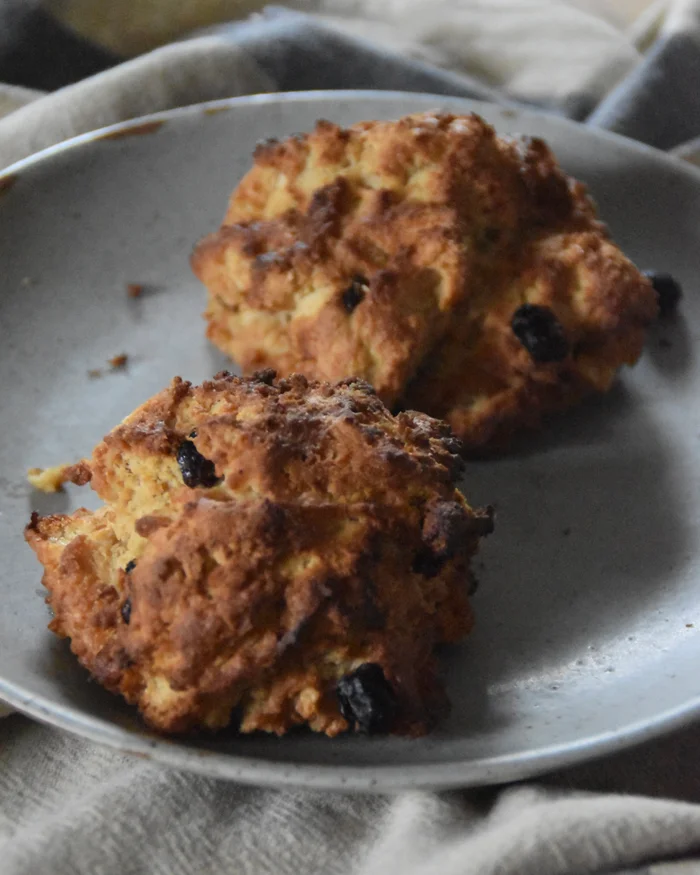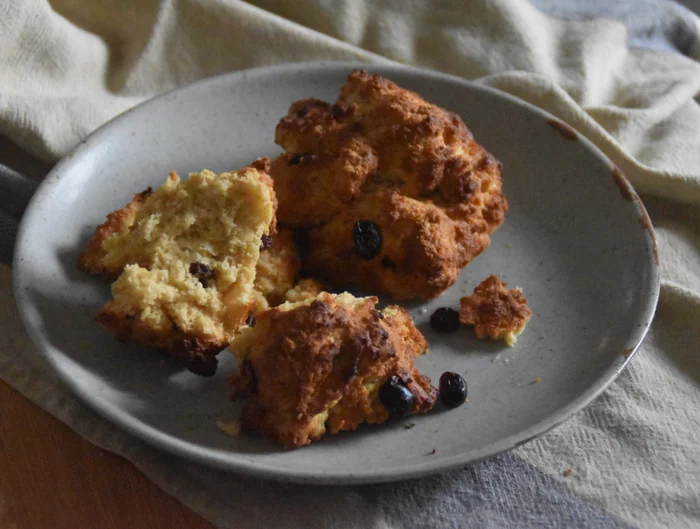Classic scones made with barley flour instead of wheat flour are golden and malty. A one bowl recipe which comes together in a pinch in the air fryer!

There are two kinds of scones: the craggy kind that looks like a mound; and the perfect flat triangles. These one-bowl scones are very much the former. All you need is one bowl and one fork. The scone dough is then scooped up and baked.
This recipe uses my standard scone method but replaces the wheat flour entirely with whole barley flour. This leads to a golden scone with a crumbly and tender interior and a light and crunchy crust. The barley flour makes the scone a touch crumblier and imparts a subtle rounded flavor.
This recipe for barley scones was spurred on by my impulsive buying of whole grain flours. I purchased some barley flour a while back and it has been taking up space on my baking shelf for too long. Over the past year, I have tried using barley flour in a variety of ways.
To be honest, there is a reason that it is more seldom used in my household. Unlike certain other whole grain flours, I have not found a dish that features barley flour in the same way that dark rye bread is to rye flour and crepes are to buckwheat flour. While spelt flour is extremely flexible in being a replacement for all-purpose flour in baked goods (9 times out of 10, spelt works pretty well, I think), barley flour has a bit more character.
I’ve found that barley flour works less well where you need a good amount of gluten. In breads, barley flour may compact your loaf a bit. I tend to think of barley flour as a “flavor” flour, but the flavor of barley is much more subtle than say, rye or buckwheat.
When used in 100 percent ratios, barley flour lends itself to baked goods you want to be crumbly, like butter cookies, or pie crusts. I especially like using barley flour for crusts or crunchy toppings, as the Maillard effect highlights barley’s nutty flavor. Scones are in this camp of crunchy/crumbly.
I’ve tried using 50 % barley flour and 100% barley flour in the same scone recipe. To my surprise, the 100% barley flour scone was still decent. For me, the best part of a scone is the crust. The crunchy crags juxtaposed with the tender interior is quite addictive! Barley flour works really well in this regard. It makes the entire thing more crumbly, crunchy, and interesting.

Another note, if you have white chocolate, use it. The way white chocolate chips melt and caramelize in the barley scones is divine. It’s like bits of melting snow in a barley field. The bits of white chocolate in the interior of the scone melts to be barely visible, adding sweetness and moistness in their wake. The white chocolate near the crust and the bottom of the scone expands slightly and solidifies into crunchy, caramelized “good stuff”. I’m reminded why caramelized white chocolate is an entire thing. (In the photos posted here there are only raisins added because I ran out of white chocolate, but the addition of white chocolate does make barley scones 30 to 50% better.)
Baking with Barley Flour – Overview
Bread: Barley flour in high percentages is difficult to work with in bread due to its relatively low gluten content. Barley flour is added more so for flavour, but with the caveat that barley tastes inherently mild. When barley flour is 30% (baker’s percentage) or more, my sourdough loaves tend to be noticeably denser and compact. Adding barley flour to an enriched dough recipe would be a challenge.
Cookies/Pie crust: I find barley flour to work quite well in low hydration, high fat doughs like shortbread cookies and pie crust. Barley flour makes for a crispy crust with a slightly nutty undertone. One thing to watch out for is that since barley flour is already golden, visual cues for when a crust or baked good is done will be different and it is easy to underbake a crust by accident.
Pancakes, cakes, scones: Barley flour generally works quite well for wetter doughs/batters. Since it is higher in fiber than wheat flour, using 100% barley flour made lead to a denser, “whole grain” texture. Using half barley and half wheat will give a lighter texture and is usually a good in between, but this ultimately depends on the recipe.

Making Scones in the Air Fryer
It’s surprisingly simple to make scones in the air fryer. I’ve been using the air fryer a lot for small batch baking. I like to dollop the scones directly onto the air fryer base. (My air fryer model is a multi-cooker, so the base is also a non-stick pot.) The scones should not stick so long as the air fryer base is clean and dry and made from a non-stick material. If your air fryer base is not non-stick and flat, you can dollop the scones on parchment paper and then bake on the base or in your air fryer basket (depending on the particular air fryer model and configuration and what it allows).
Nutrition for Barley Scones
I use Nutrition Value.org to calculate the nutritional value and breakdown of my baked goods recipes. You can find the nutritional breakdown for my barley scones recipe here.
Recipe Card
One Bowl Barley Scones
Ingredients
- 156 g barley flour
- 1.5 tsp baking powder 7.5 g
- 1 tsp sugar 4.2 g
- 50 g salted butter cold and cubed
- 30 g raisins white chocolate chips, or both (add more according to taste)
- 140 g milk
Instructions
- If using conventional oven, preheat to 375 F. If using air fryer, ignore this step.
- Add the barley flour, baking powder, and sugar to a mixing bowl and give it a mix.
- Add the salted butter in small cubes to the dry ingredients. Using a fork or a dough blender, smush and slice the butter until they are in slabs roughly the size of peas.
- Stir in the raisins or white chocolate.
- Add the milk and mix until a dough forms (10-20 seconds). No need to over mix. The dough will be shaggy but fairly cohesive. A few bits of butter may be visible.
- Scoop out the dough onto parchment paper or directly onto your baking surface (the air fryer base or lined baking pan), dividing into four equal mounds.
- Bake in preheated oven for 15-20 minutes OR in air fryer at 375 F for 13-18 minutes. If you are using your air fryer, there is no need to preheat.
- Serve warm, with butter, jam, or other spreads. Enjoy with a good mug of tea!
Subscribe to my newsletter
(Sporadic) updates on new posts and recipes sent straight to your inbox.

Leave a Reply